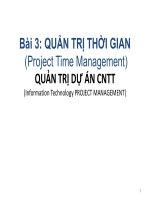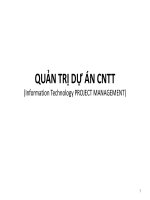Quản trị dự án công nghệ thông tin
Bạn đang xem bản rút gọn của tài liệu. Xem và tải ngay bản đầy đủ của tài liệu tại đây (4.33 MB, 158 trang )
ITSS PROJECT
MANAGEMENT FOR
EMBEDDED SYSTEM
School of Information & Communication
Technology – Hanoi University of Science
& Technology
1. Introduction
Masuda Teruaki
Email:
Dư Thanh Bình
Email:
Nguyễn Hữu Nam Dương
Email:
1.1
Introduce yourself
Your name
Your company
Your job
Your goal in this course
Your hobby
1.2
What is Project?
Definition of “Project”
A project is a temporary work to create a unique
product, service, or result.
Temporariness : Project has a definite beginning and
end.
Uniqueness : Project has new elements for the team.
So what?
Project should be managed on the assumption that the
change would happen.
Example of project
System Development Project
Build a new stadium
Introduce new process in the team
Transfer the resident
Hosting party etc...
1.3
What is Your Project?
List up below the projects which you have
experienced in your career.
Probability of project success
What do you think the rate of IT project success?
90% ?
70% ?
50% ?
30% ?
Which is the successful project?
Project A System
Delivered the system by the date agreed on.
Completed the project within budget.
Almost never used after appreciation.
Project B System
Missed the deadline.
Completed the project over budget.
Has been used over 10 years.
Which is the better project for you?
Was the Euro Tunnel Project success or
failure?
( )
1.4 Dimensions of project success
The Layer of Project Success
Future
Potential
Business Success
Project Success
Project Management Success
Level 4
Level 3
Level 2
Level 1
1.5
Project Life Cycle
Risks
Cost for change
Deliverable
Analysis
Phase
Design
Phase
Deliverable
Product
Phase
Deliverable
Test
Phase
Figure
1000
Relative cost to fix defect
Larger Software Projects
500
IBM-SSD
200
GTE
•
100
50
•
80%
20%
SAFEGUARD
•
20
•
10
Smaller Software Projects
•
5
2
•
Median (TRW Survey)
•
1
Requirements
Design
Code
Development
test
Acceptance
test
Operation
Phase in Which defect was fixed
Richard W. Selby, “Software Engineering: Barry W. Boehm's Lifetime Contributions to Software
Development, Management, and Research” P223
1.6 What is Project Management?
< Project needs Project Management >
Project Management is the application knowledge,
skills, tools, and techniques to project activities to
meet the project requirements. (PMBOK)
Project management includes general management
skill and leadership as well.
Although there are many personal element, we can
learn the way of project management as a technical
skills.
1.7
What is Leadership?
Generally, leadership is the function to show the goal
and integrate people to achieve it.
Leadership try to find out things in common.
Leadership need to get the clear image of the future.
Leadership focus on handling with complaints which can
relate to hope and spirit.
A good leader has always focused on the desirable
future to unify the team.
1.8
What is Management?
Generally, management focus on (understand&control)
the diversity of team members and complexity of
tasks.
Management try to see the different things as different.
The start point of management is in each member and
each task.
Management use the process of “Plan – Do – Check –
Act” which is called “PDCA cycle.”
A good manager find out the specifics of each
members and make full use of these talent.
Cf. Leaders versus Managers
Leader
Focus on future
Integration
Hope
Vision
Creative
Inspiring
Innovative
Opportunistic
Manager
Focus on present
Diversity
Watch
Support
Problem-solving
Analytical
Structured
Realistic
1.9
Project Stakeholders
Fill stakeholder name in the blank circles.
Clients
Manager
Top Management
Customer
End-users
Team members
Gr
PM
PM Team
PMO
Quality Assurance
Sale Division
Group leader
Project
Sponsor
Accountant
Organization
Business
Partner
1.10 Management Types
It is important to realize your management type
for improvement.
Management Type based upon the knowledge, skills,
and talent.
We need to use these to manage project.
Knowledge : Truth and lesson learned through
experience and study.
Skills : Measures for action.
Talent : Unconscious, repeated pattern of thought
and action.
If you realize your management type, you can realize
risks and take pro-active action to prevent problems.
1.11 Framework of Project Management
< Framework as a PMBOK >
Project Management Institute (PMI) published “Project
Management Body of Knowledge (PMBOK)” as a
project management standard.
PMBOK will help all project to provide shared
framework and language for project management.
PMBOK is current global standard in Project
Management (PM)
PMBOK consists of the set of processes in past
project in various industries.
Cf. Other framework of PM in the world
PRINCE2 (Projects in Controlled Environments, 2nd
version) of United Kingdom.
ICB (IPMA Competence Baseline) of International
Project Management Association in Europe.
P2M (Project & Program Management for enterprise
innovation) of Japan
Now, the workgroup, ISO/PC 236 is running to set a new
international PM standard which is called “ISO 21500.”
(PMI in taking initiative in the WG.)
1.12 Five Process Groups
PMBOK(R) grouped many project processes into five categories,
Project Management Process Groups (or Process Groups):
Monitoring &
Controlling
includes all process
groups
Monitoring
& Controlling
Manage QCD with risks.
Planning
Initiation
Closing
Executing
1.13
9 Knowledge Areas
1. Project Integration Management
2. Project Scope Management
3. Project Time Management
4. Project Cost Management
5. Project Quality Management
6. Project Human Resource Management
7. Project Communication Management
8. Project Risk Management
9. Project Procurement Management
1.14 Input - Tools & Technique - Output
PMBOK use the process framework;
Input – Tools & Technique – Output
Input
- Activity List
- Activity
Resource
Requirements
- Project Scope
Requirements
Tools
& Technique
- Expert
Judgment
- Analogous
Estimating
- Parametric
Estimating
- Reserve
Analysis
Output
- Activity
Duration
Estimates
- Project
Document
Updates
1.15 Framework for “Problem Solving”
< Constraint Condition >
Natural Disaster, World Recession, etc (Absolute)
Law, Restricted Budget, Dead line, etc (Relative)
< Input >
< Process >
- Staffs
- Products
- Budget
- Information
etc..
- Management Way
- How to operate
- Schedule
- Sequence of task
etc..
Past (Cause)
Goal
Objective
Plan
Problem
Output
Present (Effect)









